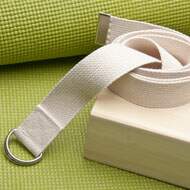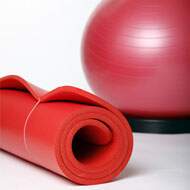Guide To Use Yoga Props To Your Advantage
Yoga is an ancient practice that involves moving the body into various positions and controlling one’s breathing. Yoga has become popular in the recent years as an alternative lifestyle to better mental, physical and emotional health. If you have been practicing yoga at home or with a trainer at yoga club, you’ll find that there are yoga props (especially useful for beginners) that can help ease you into the more advanced poses.
Here’s a list of some of the props you can use.
For better cushioning and grip: A yoga mat
Although most kinds of yoga can be performed on bare ground, yoga mats help provide excellent traction so that you can concentrate on your posture instead of worrying about slipping. The materials usually used in the manufacture of yoga mats are vinyl and PVC, but rubber and organic cotton varieties are also available.Apart from providing better grip, stability, and improved balance, yoga mats also help cushion the hard surface. This is especially useful when dong poses that require you to bear your weight on your hands, head, shoulders, and knees. One particular type of yoga mat has a surface with protrusions like knobs, which provide something akin to an acupressure massage to the person using the mat. While some people might find the protrusions uncomfortable, others may find it very relaxing.
When buying a yoga mat, try out different materials first. Try out various poses on each of them to determine which one suits you the best. Remember, like the mat with protrusions, what suits your friend, may not always be best for you. Once you have bought a mat, you can increase its shelf-life by taking regular care of it. When you are not using your yoga mat, make sure you store it in a separate bag. This will keep it dry and clean during storage and transport.
What do you do with a yoga block?
While there is a lot of equipment being used in yoga practice, yoga blocks are considered the most popular for both beginners and advanced students. The materials used in the manufacture of yoga blocks include wood, foam, and cork. Yoga blocks are essentially useful for performing more advanced yoga postures as they provide increased stability, for example, in poses where you cannot touch the ground with your hands, you can place a yoga block and use that for support. A yoga block should ultimately provide stability and be able to bear the weight of an adult, so when buying one, concentrate on picking one that will suit you as opposed to choosing between the materials used in manufacture. Yoga blocks are mostly used in poses like the Adho Mukha Svanasana (Downward Facing Dog) to relieve the pressure that is felt on the upper body and arms.
For performing poses that require flexibility: Yoga straps
A yoga strap is usually used to perform postures that are a little out of reach for the practitioner. This is especially useful to beginners who haven’t yet achieved the flexibility required to do a full pose. Some of the uses of the yoga strap can be understood as follows:
- Wrap the strap over your feet when you cannot reach/touch your toes and hold the strap instead, for example, when doing the Uttanasana (Standing Forward Bend).
- You can similarly loop the strap around the feet when doing the Paschimottanasana (Seated Forward Bend).
- You can also put the arms though the loops of a yoga strap to help keep them in place when performing the Halasana (Plow Pose) or the Setu Bandha Sarvangasana (Bridge Pose).
Yoga straps are usually made from hemp or cotton. When buying one, make sure that the strap you pick up is moisture absorbent.
When a mat is not cushioning enough: A yoga blanket
Yoga blankets are used when extra support or cushioning is required. Although the yoga blanket is not a main part of yoga equipment, many individuals find it to be a worthwhile investment. The yoga blanket can be used under the knees or hips in supine and seated poses to provide support and stability.
Why do you need a yoga bolster?
A yoga bolster is a like a regular bolster and is similar to a yoga block. However, yoga blocks and bolsters are used differently. Yoga bolsters aid the body in various yoga poses by modifying or deepening them. It is mainly used in supine poses where one can support his/her back on it. While you could also use any soft object like an additional yoga mat or a towel instead of a bolster, experimenting with bolsters of different shapes and sizes to see which one feels right for you can be a fun experience.
Do you need a yoga towel?
A yoga towel is made specifically to fit on the yoga mat while you perform the poses. If you find yourself sweating profusely and slipping off the mat, you can use a yoga towel to deal with this problem. The yoga towel is used often during Hot Yoga or Bikram Yoga, but can be used during any practice. Yoga towels are also made to be super absorbent and fast drying.
Read more articles from the Yoga Accessories Category.

 Find Pose
Find Pose

